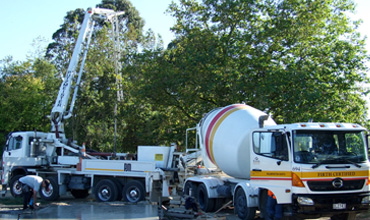
A boom pump is a type of concrete pump that is widely used in construction and infrastructure projects. It is a versatile machine that can deliver concrete to various locations on a construction site, including high-rise buildings, bridges, and tunnels. In this article, we will discuss the working fundamentals of boom pump concrete and how it operates.
Working Principal
The boom pump concrete works by pumping concrete through a flexible hose that is attached to a hydraulic boom. The boom is made up of several articulated sections that can extend up to 100 feet, depending on the model. This allows the operator to reach difficult-to-access areas with ease.
The concrete is mixed in a truck-mounted mixer and then transported to the boom pump. Once it arrives, the concrete is fed into a hopper that is connected to the pump's hydraulic system. The hydraulic system pumps the concrete through the boom's flexible hose and into the desired location.
The boom pump's hydraulic system is powered by a diesel engine that is mounted on the truck chassis. This engine drives a hydraulic pump that generates the pressure needed to push the concrete through the boom. The operator can control the flow rate and the direction of the concrete using a remote control system.
Why Boom Pump Concrete Is A Popular Concrete Pumping Method
One of the key advantages of using a boom pump is that it allows for precise placement of the concrete. The operator can adjust the height and angle of the boom to deliver the concrete exactly where it is needed. This is particularly useful when working on complex structures such as curved walls or bridges.
Another advantage of the boom pump is that it can deliver concrete quickly and efficiently. The pump can deliver up to 150 cubic yards of concrete per hour, which is much faster than traditional methods such as using a crane and bucket. This can help to save time and labor costs on construction sites.
The boom pump is also a safer option than traditional concrete placement methods. The operator can control the flow of the concrete from a safe distance, which reduces the risk of accidents or injuries. Additionally, the boom pump can be set up in a way that minimizes the need for workers to be in close proximity to the concrete delivery area.
When using a boom pump, it is important to ensure that the concrete mixture is suitable for pumping. The concrete should have a slump of at least four inches and should not contain any large aggregates that could clog the hose. The operator should also be aware of the maximum pumping distance for the particular boom pump being used.
Conclusion
The boom pump is a valuable tool for the construction industry. Its ability to deliver concrete quickly and precisely makes it a popular choice for infrastructure projects around the world. By understanding the working fundamentals of boom pump concrete, construction professionals can make informed decisions about the best equipment for their projects.